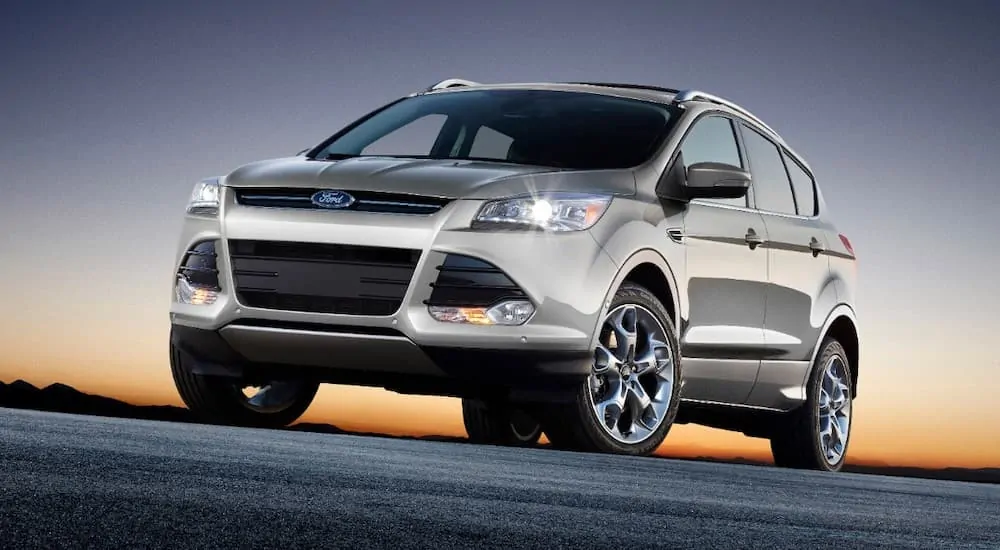It has been 20 years since Ford introduced its entry into the ever-popular crossover SUV model category. The Ford Escape first appeared in time for the 2001 model year and, over 4 different generations, has staked its claim as one of the most versatile and affordable crossovers on the market. The Ford Escape is a four-door SUV that seats up to 5 passengers. It has a sporty exterior and a roomy interior with plenty of space for you, your friends, and all of your stuff. It also has a great fuel economy, whether you choose to go with the standard front-wheel drivetrain or opt for the available all-wheel drive to provide greater traction and handling. Best of all, with 20 years of models available, you are sure to find the used Ford Escape that best suits you and your lifestyle.
That is because the Ford designers and engineers have made sure there is a Ford Escape that fits all generations of drivers. Older drivers will appreciate the ease of entry and exit into the Escape. Frugal buyers will love the excellent fuel efficiency of the Escape. Young drivers will dig the Escape’s fun looks and exceptional performance. Parents will like the fact that there is plenty of space in the back of the Escape, so the kids won’t constantly complain, “Are we there yet?” People who want a vehicle that can be used for cargo, as well as passengers, will appreciate the ease with which the Escape’s rear seat can be folded down to provide a wealth of space for the stuff you need to move. Whoever you are, if you are in the market for a great crossover SUV at an affordable price, you should strongly consider buying a used Ford Escape from one of these four generations.
The Current Generation of the Escape
The current model Escape was introduced for the 2020 model year and features your choice of four different trim levels ranging from the S to the SE, SEL, and fully loaded Titanium. Ford also offers two great engines for the Escape. The 1.5-liter Ti-VCT GTDI I-3 engine produces 181 horsepower and 190 pounds-feet of torque, delivering 27 miles per gallon in city driving and 33 miles per gallon on the highway for front-wheel drive models. If you choose to go with the all-wheel drive Escape, you should expect a slight drop off of 26 miles per gallon in the city and 31 miles per gallon on the highway.
The other engine is a high-performance 2.0-liter EcoBoost engine that produces 250 horsepower and 280 pounds-feet of torque. This is only available on all-wheel drive Escapes, providing fuel economy of 23 miles per gallon in city driving and 31 miles per gallon on the highway. All current models of the Ford Escape feature an 8-speed automatic transmission for maximum control.
There is a full 37.4 cubic feet of space in the current model’s trunk that easily increases to 65.4 cubic feet with the rear row of seats folded down. The Escape also features the Ford SYNC 3 infotainment on an easy-to-use color touchscreen, combining a high-quality sound system, Apple CarPlay and Android Auto capability, Bluetooth connectivity, and all the key information you will need while driving your fourth generation Ford Escape.
Where it All Began
The folks at Ford saw a need for an SUV that was not as big as the midsize and full-size models out on the roads. So, in 2000, Ford introduced the Escape, a sporty little SUV in a category that would come to be known as a crossover. The Escape was an immediate hit as drivers who wanted better fuel economy and easier drivability left their bigger SUVs behind and escaped to the Ford Escape. Similarly, many folks saw the advantage of switching from their sedans and coupes to an SUV without the hassle of getting comfortable driving a vehicle that handled more like a truck. These drivers also escaped their sedans and coupes to the Ford Escape.
What makes the Ford Escape so special is its great combination of a roomy interior, an easy vehicle to handle, exceptional fuel economy, and solid performance. The first generation Escape came in two trims: XLS and XLT, with the latter being the top trim level. In addition, Ford offered Sport versions of the XLS and XLT that mainly added larger 16-inch alloy wheels to the existing trim.
The original Ford Escape is front-wheel drive standard with available 4-wheel drive. The 4-wheel drive system on the first generation Escape allows you to choose between 4X4 lock and 4X4 automatic, which switches to rear-wheel drive when the Escape is highway driving. In addition, there are two engine options on the first generation Escape.
The base engine is a 2.0-liter Zetec 4-cylinder gas engine that is paired with a 5-speed manual transmission. This engine produces 130 horsepower and 135 pounds-feet of torque. A larger 3.0-liter Duratec V6 comes with a 4-speed automatic transmission and produces 200 horsepower and 200 pounds-feet of torque. The Escape with the larger engine is capable of towing up to 3,500 pounds of trailer.
The original Escape was configured with 33 cubic feet of cargo space in the trunk that expands to 68.5 cubic feet with the rear seats down. Since the original base engine was manual transmission only, you should only consider this model if you are comfortable working a stick and clutch.
Ford actually rectified this issue with the 2005 model year, replacing the Zetec engine with a 2.3-liter 4-cylinder gas engine that produces 153 horsepower and 152 pounds-feet of torque. Not only is it a more powerful engine, but also it was offered with a choice of 5-speed manual transmission or 4-speed automatic transmission. So, if you want a great value in Escape but can only drive an automatic, look for the base engine with the automatic transmission. This model was built from the 2000 model year to the 2007 model year.
Escape to the Second Generation
Ford decided to improve upon its successful Escape by introducing a second generation of the model with a more rugged profile than its predecessor and improved performance. They also added a new top-of-the-line trim, the Limited, to the existing XLS and XLT trim levels. The engine options were changed, with the XLS and XLT coming equipped with a 2.5-liter I-4 gas engine.
This engine gave drivers a choice of 5-speed manual transmission or 4-speed automatic transmission on an engine that produces 171 horsepower and 152 pounds-feet of torque. This engine is especially efficient, providing 20 miles per gallon in city driving and 28 miles per gallon on the highway with front-wheel drive, and 19 miles per gallon in the city and 25 miles per gallon on the highway with all-wheel drive.
The other engine is a 3.0-liter V6 that is standard on the Escape Limited for the second generation. This engine is paired with a 4-speed automatic transmission and produces 240 horsepower and 193 pounds-feet of torque. It provides a solid fuel economy of 18 miles per gallon in city driving and 26 miles per gallon with front-wheel drive, and 17 miles per gallon in the city and 24 miles per gallon on the highway with available all-wheel drive.
The second-generation model was produced until the 2012 model year, which also saw the introduction of the first Escape Hybrid. If you are looking to tow trailers, your best bet is the Escape Limited, which is rated to tow up to 3,500 pounds. If you are looking for fuel efficiency, then you should look for a used Escape XLS or XLT. Whichever one you choose, you are getting plenty of cargo space with 29 cubic feet in the trunk and an overall 66 cubic feet with the rear seats folded down.
Third Times the Charm With Escape
Not content to rest on its laurels, Ford decided to introduce an all-new Escape for the 2013 model year with smoother lines, a longer wheelbase and wider frame, and four all-new trim levels. Gone were the XLS, XLT, and Limited, replaced with the S, SE, SEL, and Titanium, the same trim levels on the current fourth generation model. The redesign provides an expanded cargo space of 34.3 cubic feet in the Escape’s trunk with a full 68.1 cubic feet when the rear seats are folded down.
Also, Ford added its MyFord Touch information system to the Escape for the third generation incorporating SYNC on an 8-inch color touchscreen. Keep this in mind if you are looking for a used Escape with an advanced infotainment system. This is especially so since the S and SE do not necessarily feature a SYNC 3 except for the 2019 model year of the SE when it became standard to that trim.
The other major change for the third generation was the incorporation of three different engines depending on the trim level. The Escape S is equipped with a 2.5-liter 4-cylinder engine that produces 168 horsepower and 167 pounds-feet of torque. This model is front-wheel drive only.
The Escape SE and SEL feature a 1.6-liter Turbo I-4 that produces 178 horsepower and 184 pounds-feet of torque, with your choice of front-wheel or all-wheel drive. The Titanium comes with a powerful 2.0-liter Turbo I-4 that provides 240 horsepower and 270 pounds-feet of torque. The Titanium can tow up to 3,500 pounds of trailer. For the third generation, Ford stopped offering a manual transmission, pairing all the engine options with a 6-speed automatic transmission.
The thing that really stands out about the third generation of the Ford Escape is fuel economy. The S provides 22 miles per gallon in city driving and 31 miles per gallon on the highway. The SE and SEL top this with 23 miles per gallon in city driving and 33 miles per gallon in highway driving. In addition to exceptional performance, the Titanium provides a great fuel efficiency of 22 miles per gallon in the city and 30 miles per gallon on the highway.
For over four generations spanning over 20 years of automotive production, Ford Escape has provided drivers with an amazing crossover that can suit the wants and needs of every generation of driver. Whether you want exceptional performance, a roomy interior, solid fuel economy, or plenty of cargo space, the Escape is the crossover to consider no matter which generation, trim, or engine option you choose.






